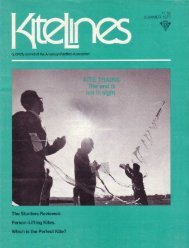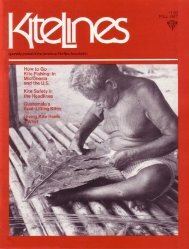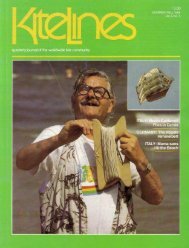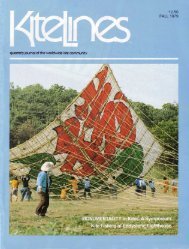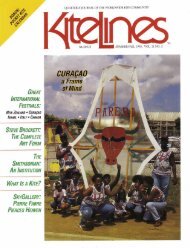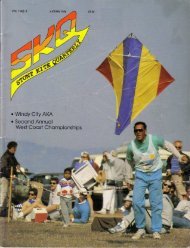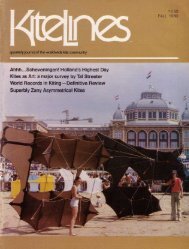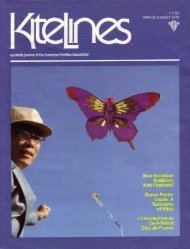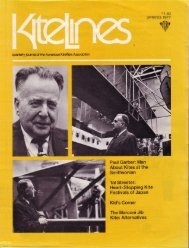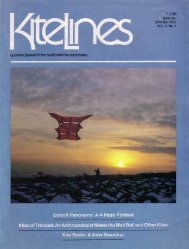Kite Lines - Vol.3 No. 1 - KiteLife
Kite Lines - Vol.3 No. 1 - KiteLife
Kite Lines - Vol.3 No. 1 - KiteLife
- No tags were found...
You also want an ePaper? Increase the reach of your titles
YUMPU automatically turns print PDFs into web optimized ePapers that Google loves.
entered their minds and as a consequencethey had not yet stumbled onto Jalbert'swork with inflated kites .The early experiments with the twosmall wings were encouraging . "Theyseemed to want to go up into the air,"Ray said . "We decided to try an eightfootspan .""To keep the wind spread across itsspan we introduced a rigid cross stick atthe leading edge . That happened ratherearly in our experiments," Andrew said ."Then it was a question of where totie the line . We had a fan of bridle linespositioned along the beam at each gore,all gathered together and tied to a singleflying line . This line arrangement held usback quite a bit . The wing tended to liftslightly into the air but would wag backand forth on the towing line quite erratically.Quite fortunate, this erratic behavior,as it turned out, for at one time the wingflipped over on its back and took offagain . There was an immediate improvementin its lift characteristics . It wentback up in a wide high flight, arcingbroadly but gently left and right . We thenthought of trying to induce lateral control .At this juncture we were closer to makinga kite," Andrew concluded ."It was a bit like a cricket match asthis thing rose back into the air . Peoplewatching started spontaneously clappingLeft, an early six-foot polyethyleneFlexifoil tracking close to the ground ;1973, Newcastle-upon-Tyne .Below, Ray Merry flying the early mattressbag on -inch model aircraft elastic line .and cheering," Ray recalled ."It was still very much a hit and missaffair whether we could get the thing tofly at all. We put a lot of energy intomaking it fly each time we went out .Some days we would just not get anyflight at all," Ray said .The industrial design faculty couldsee little practical use for the invention ;it was recognition from the fine artsdepartment that provided an ongoingsympathetic and encouraging audiencealongwith friends and family members ."It was all a practice those years atNewcastle," Andrew continued . "Evenafter we'd finished at Newcastle we hadn'treally developed a foolproof kite . The lastthing we did at school was to build thefirst fabric kite . It had a 15-foot wingspan and was made of proofed nylon withthe help of a seamstress in the fashionschool . Brenda Smith (Ray's longtimefriend of college days, now secretary ofFlexifoil, Ltd .) actually made the firstsix-foot wing of spinnaker nylon thesummer after we'd finished college ."Brenda's mother suggested they considerusing net curtaining and this led themto the net-covered narrow leading edgeslot which now exists on the production'foil . A college lecturer who had witnessedthe activity suggested that they reduce thenumber of bridles to three, one at eachwing tip and one in the center . (Thecenter one was necessary to give theoriginal wooden spar needed strength .)Erratic behavior was still the rule .Once, Ray averted a dive, turning thecontrol bar completely over in a reflexivemovement . The wing responded with awide loop .Somewhat later, Andrew's parentscame up to Newcastle . "We went outflying together . My father did a loop rightaround without turning the control barover . That was a moment! Until then wehad thought it necessary to immediatelyturn the bar over to take the line loopsout . The control bar had been, right along,the line counterpart of the kite spar-andequally importantly, a really useful wayto quickly take up our flying lines. Anythingwe could do to get us through tangledlines which were quite frequent wasmost appreciated . In the early stages offlying the wing as a kite, the bar wasshorter than its current three-foot length .We reached out to pull on the individuallines to control the kite . It was later thatwe went to the longer bar and pulling eachend of the bar back for controlled flight ."We experimented with a variety ofpositions for the spar in relation to thelittle vents . We had eight different airfoilshapes by then-six variations on wingspan and two chords . We hadn't completelyfathomed out the workings of the 'foil .We didn't really know how or why itworked . We realized what effect the generalnature of the shape had on its flight(the narrow chord reduced drag andinduced speed), but we didn't fully appreciatethe importance of the flexing spar ."We always wanted to keep it as simpleas possible . We would really have liked tohave done away with the spar," Ray mentioned. "The spar kept us away from theParafoil configuration and its steady flightcharacteristics ."Andrew commented, "But we knewthat this would mean shrouds (as withParafoils), which would have been morecomplicated, not simple, visually, as werequired ."Ray said, "We were still tying the flyinglines off, staking them into the ground .We wondered if we or anyone else couldendure the frustration of tangled flyinglines in a controlled flight ."At the risk of implying at this latepoint that there was outright theft ofJalbert's Parafoil design, I asked for clarificationon what effect the Parafoil had



